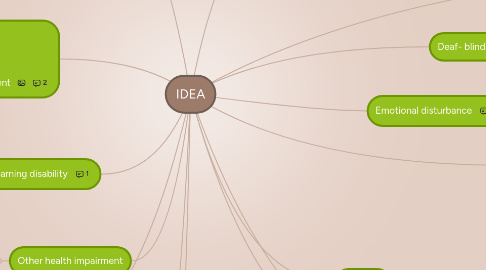IDEA
Charity Yiにより


1. Intellectual disability
1.1. below average of intellectual functioning that led into a lack of behavior
1.2. Case Study: Matthew's Story. He has been getting special education services since elementary school. This has been helping him fit to his special learning needs. It has also encouraged him to continue to learn and not let his disability stop him
1.3. Interventions/ Modifications and Assistive Technology: School staff and the child's parents develop an IEP, continue to be involved in general education curriculum, special instruction, personnel, equipment or other accommodations that allow children to be educated with non- disabled children.
2. Multiple disabilites
3. Orthopedic impairment
3.1. impairments caused by disease like bone tuberculosis and other causes like amputation
4. Other health impairment
4.1. limited alertness due to chronic or acute health problems like A.D.D. or diabetes.
5. Specific learning disability
5.1. Interventions/ Modification and Assistive Technology: School staff and parents meet and develop an IEP, AT, and AIM (accessible instructional materials). Teachers also need to give instructions and accommodations that fit the child's needs like giving more time to finish homework and allowing students with writing difficulties use a computer with specialized software.
6. Speech or language impairment
7. Traumatic brain injury
7.1. Case Story: Susan's Story. She was 7 when she was hit by a car while she was riding her bike. She head was hit very hard and she got a traumatic brain injury. Fortunately she has made a full recovery since all her broken bones have healed. She does take longer time to do things, cannot remember well or find words that she wants to use.
8. Autism
9. Deaf- blindness
9.1. hearing and visual impairments where communication, developmental and education may be affected
9.2. Interventions/ Modifications and Assisted Technology: ALDs, a small microphone worn by the instructor that increases volume and clarity of the class for the student who wears the device, interpreters, large print/ braille materials or taped text books, and appropriate classroom settings.
10. Deafness
10.1. cannot hear and affects the child learning linguistic information
10.1.1. Interventions/ Modifications and Assistive Technology: EI services like AT, audiology, service coordination. special instruction. speech and language services, and transportation.
10.1.1.1. Case Story: Caroline's Story. She has been wearing her hearing aid since she was three. She was diagnosed with a moderate hearing loss. Caroline's parents did not realize that she had issues with hearing until she started preschool. Her teachers suggested her parents to get Caroline checked. After the doctor had diagnosed Caroline she was immediately fitted with hearing aids. She receives special services such as getting speech therapy and other services.
